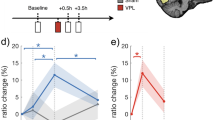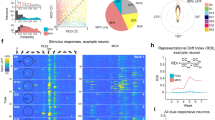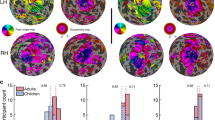Abstract
Several aspects of cortical organization are thought to remain plastic into adulthood, allowing cortical sensorimotor maps to be modified continuously by experience. This dynamic nature of cortical circuitry is important for learning, as well as for repair after injury to the nervous system. Electrophysiology studies suggest that adult macaque primary visual cortex (V1) undergoes large-scale reorganization within a few months after retinal lesioning, but this issue has not been conclusively settled. Here we applied the technique of functional magnetic resonance imaging (fMRI) to detect changes in the cortical topography of macaque area V1 after binocular retinal lesions. fMRI allows non-invasive, in vivo, long-term monitoring of cortical activity with a wide field of view, sampling signals from multiple neurons per unit cortical area. We show that, in contrast with previous studies, adult macaque V1 does not approach normal responsivity during 7.5 months of follow-up after retinal lesions, and its topography does not change. Electrophysiology experiments corroborated the fMRI results. This indicates that adult macaque V1 has limited potential for reorganization in the months following retinal injury.
This is a preview of subscription content, access via your institution
Access options
Subscribe to this journal
Receive 51 print issues and online access
$199.00 per year
only $3.90 per issue
Buy this article
- Purchase on SpringerLink
- Instant access to full article PDF
Prices may be subject to local taxes which are calculated during checkout





Similar content being viewed by others
References
Gilbert, C. D. & Wiesel, T. N. Receptive field dynamics in adult primary visual cortex. Nature 356, 150–152 (1992)
Gilbert, C. D., Hirsch, J. A. & Wiesel, T. N. Lateral interactions in visual cortex. Cold Spring Harb. Symp. Quant. Biol. 55, 663–677 (1990)
Heinen, S. J. & Skavenski, A. A. Recovery of visual responses in foveal V1 neurons following bilateral foveal lesions in adult monkey. Exp. Brain Res. 83, 670–674 (1991)
Darian-Smith, C. & Gilbert, C. D. Topographic reorganization in the striate cortex of the adult cat and monkey is cortically mediated. J. Neurosci. 15, 1631–1647 (1995)
Gilbert, C. D. Adult cortical dynamics. Physiol. Rev. 78, 467–485 (1998)
Kaas, J. H. et al. Reorganization of retinotopic cortical maps in adult mammals after lesions of the retina. Science 248, 229–231 (1990)
Pettet, M. W. & Gilbert, C. D. Dynamic changes in receptive-field size in cat primary visual cortex. Proc. Natl Acad. Sci. USA 89, 8366–8370 (1992)
Chino, Y. M., Kaas, J. H., Smith, E. L., Langston, A. L. & Cheng, H. Rapid reorganization of cortical maps in adult cats following restricted deafferentation in retina. Vision Res. 32, 789–796 (1992)
Calford, M. B., Schmid, L. M. & Rosa, M. G. Monocular focal retinal lesions induce short-term topographic plasticity in adult cat visual cortex. Proc. R. Soc. Lond. B 266, 499–507 (1999)
Schmid, L. M., Rosa, M. G. & Calford, M. B. Retinal detachment induces massive immediate reorganization in visual cortex. Neuroreport 6, 1349–1353 (1995)
DeAngelis, G. C., Anzai, A., Ohzawa, I. & Freeman, R. D. Receptive field structure in the visual cortex: does selective stimulation induce plasticity? Proc. Natl Acad. Sci. USA 92, 9682–9686 (1995)
Murakami, I., Komatsu, H. & Kinoshita, M. Perceptual filling-in at the scotoma following a monocular retinal lesion in the monkey. Vis. Neurosci. 14, 89–101 (1997)
Horton, J. C. & Hocking, D. R. Monocular core zones and binocular border strips in primate striate cortex revealed by the contrasting effects of enucleation, eyelid suture, and retinal laser lesions on cytochrome oxidase activity. J. Neurosci. 18, 5433–5455 (1998)
Rosa, M. G., Schmid, L. M. & Calford, M. B. Responsiveness of cat area 17 after monocular inactivation: limitation of topographic plasticity in adult cortex. J. Physiol. (Lond.) 482, 589–608 (1995)
Schmid, L. M., Rosa, M. G., Calford, M. B. & Ambler, J. S. Visuotopic reorganization in the primary visual cortex of adult cats following monocular and binocular retinal lesions. Cerebral Cortex 6, 388–405 (1996)
Logothetis, N. K., Guggenberger, H., Peled, S. & Pauls, J. Functional imaging of the monkey brain. Nature Neurosci. 2, 555–562 (1999)
Logothetis, N. K., Pauls, J., Augath, M., Trinath, T. & Oeltermann, A. Neurophysiological investigation of the basis of the fMRI signal. Nature 412, 150–157 (2001)
Tolias, A. S., Smirnakis, S. M., Augath, M. A., Trinath, T. & Logothetis, N. K. Motion processing in the macaque: revisited with functional magnetic resonance imaging. J. Neurosci. 21, 8594–8601 (2001)
Brewer, A. A., Press, W. A., Logothetis, N. K. & Wandell, B. A. Visual areas in macaque cortex measured using functional magnetic resonance imaging. J. Neurosci. 22, 10416–10426 (2002)
Engel, S. A., Glover, G. H. & Wandell, B. A. Retinotopic organization in human visual cortex and the spatial precision of functional MRI. Cerebral Cortex 7, 181–192 (1997)
Boynton, G. M., Engel, S. A., Glover, G. H. & Heeger, D. J. Linear systems analysis of functional magnetic resonance imaging in human V1. J. Neurosci. 16, 4207–4221 (1996)
Wandell, B. A. Computational neuroimaging of human visual cortex. Annu. Rev. Neurosci. 22, 145–173 (1999)
Sclar, G., Maunsell, J. H. R. & Lennie, P. Coding of image contrast in central visual pathways of the macaque monkey. Vision Res. 30, 1–10 (1990)
Lee, T. S., Mumford, D., Romero, R. & Lamme, A. F. The role of the primary visual cortex in higher level vision. Vision Res. 38, 2429–2454 (1998)
Rossi, A. F., Desimone, R. & Ungerleider, L. G. Contextual modulation in primary visual cortex of macaques. J. Neurosci. 21, 1698–1709 (2001)
Li, W., Thier, P. & Wehrhahn, C. Neuronal responses from beyond the classic receptive field in V1 of alert monkeys. Exp. Brain Res. 139, 359–371 (2001)
Rossi, A. F., Rittenhouse, C. D. & Paradiso, M. A. The representation of brightness in primary visual cortex. Science 273, 1104–1107 (1996)
Cavanaugh, J. R., Bair, W. & Movshon, J. A. Nature and interaction of signals from the receptive field center and surround in macaque V1 neurons. J. Neurophysiol. 88, 2530–2546 (2002)
Hendry, S. H. & Jones, E. G. Reduction in number of immunostained GABAergic neurones in deprived-eye dominance columns of monkey area 17. Nature 320, 750–756 (1986)
Rosier, A. M. et al. Effect of sensory deafferentiation on immunoreactivity of GABAergic cells and on GABA receptors in the adult cat visual cortex. J. Comp. Neurol. 359, 476–489 (1995)
Das, A. & Gilbert, C. D. Long-range horizontal connections and their role in cortical reorganization revealed by optical recording of cat primary visual cortex. Nature 375, 780–784 (1995)
Volchan, E. & Gilbert, C. D. Interocular transfer of receptive field expansion in cat visual cortex. Vision Res. 35, 1–6 (1995)
Fiorani, M. Jr, Rosa, M. G. P., Gattass, R. & Rocha-Miranda, C. E. Dynamic surrounds of receptive fields in primate striate cortex: A physiological basis for perceptual completion? Proc. Natl Acad. Sci. USA USA89, 8547–8551 (1992)
Levitt, J. B. & Lund, J. S. The spatial extent over which neurons in macaque striate cortex pool visual signals. Vis. Neurosci. 19, 439–452 (2002)
Baker, C. I., Peli, E., Knouf, N. & Kanwisher, N. G. Reorganization of visual processing in macular degeneration. J. Neurosci. 25, 614–618 (2005)
Sunness, J. S., Liu, T. & Yantis, S. Retinotopic mapping of the visual cortex using functional magnetic resonance imaging in a patient with central scotomas from atrophic macular degeneration. Ophthalmology 111, 1595–1598 (2004)
Darian-Smith, C. & Gilbert, C. D. Axonal sprouting accompanies functional reorganization in adult cat striate cortex. Nature 368, 737–740 (1994)
Pons, T. P., Garraghty, P. E. & Mishkin, M. Lesion-induced plasticity in the second somatosensory cortex of adult macaques. Proc. Natl Acad. Sci. USA 85, 5279–5281 (1988)
Pons, T. P. et al. Massive cortical reorganization after sensory deafferentation in adult macaques. Science 252, 1857–1860 (1991)
Sadato, N., Okada, T., Honda, M. & Yonekura, Y. Critical period for cross-modal plasticity in blind humans: a functional MRI study. Neuroimage 16, 389–400 (2002)
Sadato, N. et al. Activation of the primary visual cortex by Braille reading in blind subjects. Nature 380, 526–528 (1996)
Cohen, L. G. et al. Functional relevance of cross-modal plasticity in blind humans. Nature 389, 180–183 (1997)
Angelucci, A., Levitt, J. B. & Lund, J. S. Anatomical origins of the classical receptive field and modulatory surround field of single neurons in macaque visual cortical area V1. Prog. Brain Res. 136, 373–388 (2002)
Angelucci, A. et al. Circuits for local and global signal integration in primary visual cortex. J. Neurosci. 22, 8633–8646 (2002)
Koeberle, P. D. & Bahr, M. Growth and guidance cues for regenerating axons: where have they gone? J. Neurobiol. 59, 162–180 (2004)
Fenrich, K. & Gordon, T. Canadian Association of Neuroscience review: axonal regeneration in the peripheral and central nervous systems—current issues and advances. Can. J. Neurol. Sci. 31, 142–156 (2004)
Wandell, B. A., Chial, S. & Backus, B. Visualization and measurement of the cortical surface. J. Cogn. Neurosci. 12, 739–752 (2000)
Acknowledgements
We thank J. Horton and A. Wade for comments and suggestions, and C. Riedinger, R. Esaki, I. Kim, E. Lit, J. Pauls and J. Werner for technical help. We also thank L. Vaina, B. Rosen and the members of our laboratory for their advice and support. This work received support from a National Eye Institute (NEI) grant (S.M.S.), an NEI postdoctoral fellowship grant (A.S.T.), an NEI grant to B.A.W., a Howard Hughes Medical Institute Physician Postdoctoral Fellowship (S.M.S.), a National Institute of Neurological Disorders and Stroke grant (A.A.B.), a grant from the Max Planck Society and a Deutsche Forschungsgemeinschaft grant. S.M.S. is currently also affiliated with the Athinoula Martinos Center for Biomedical Imaging, Massachusetts General Hospital, CNY-Building 149, 13th Street, Charlestown, Massachusetts 02129-2000, USA.Author Contributions S.M.S. took primary responsibility for the design and execution of all experiments, as well as for performing the analysis and preparing the manuscript. A.A.B. and M.C.S. contributed equally to this work. M.C.S. helped perform MRI experiments and analysis. A.A.B. helped with the analysis and familiarized us with the mrVISTA software. A.S.T. was intimately involved with all aspects of the work. M.A. provided technical support with the MRI experiments. A.S. provided help with the histological preparations and W.I. helped with retinal lesioning. B.A.W. and N.K.L. provided resources and acted in supervisory roles.
Author information
Authors and Affiliations
Corresponding author
Ethics declarations
Competing interests
Reprints and permissions information is available at npg.nature.com/reprintsandpermissions. The authors declare no competing financial interests.
Supplementary information
Supplementary Figure S1
The BOLD signal inside the V1 lesion projection zone (LPZ) remains at noise levels and the LPZ does not shrink as a function of time post-lesion. (PPT 692 kb)
Supplementary Figure S2
The profile of raw (not normalized) BOLD coherence across the lesion projection zone border does not shift or change slope as a function of time post lesion. (PPT 422 kb)
Supplementary Figure S3
Extraclassical multi-unit firing rate transients observed in animals without lesions. (PPT 604 kb)
Supplementary Figure S4
Comparison between pre-lesion and post-lesion coherence maps inside the V1 lesion projection zone. (PPT 580 kb)
Supplementary Figure S5
Comparison between pre-lesion and post-lesion visually driven BOLD modulation strength inside the lesion projection zone. (PPT 269 kb)
Supplementary Legends
Legends to accompany the above Supplementary Figures. (DOC 35 kb)
Rights and permissions
About this article
Cite this article
Smirnakis, S., Brewer, A., Schmid, M. et al. Lack of long-term cortical reorganization after macaque retinal lesions. Nature 435, 300–307 (2005). https://doi.org/10.1038/nature03495
Received:
Accepted:
Issue Date:
DOI: https://doi.org/10.1038/nature03495



